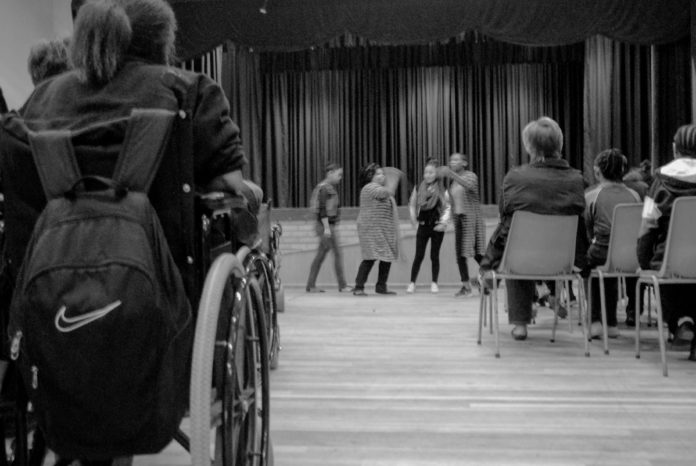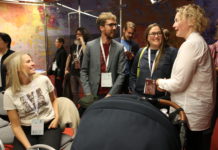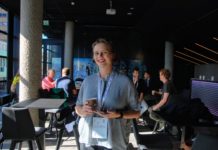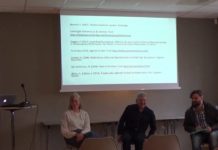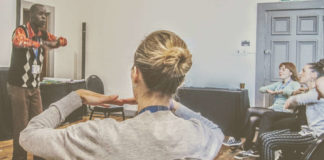Carpe Diem School provides for “Physical-, learning- and intellectually impaired learners between the ages of 6 and 18 years, that cannot be accommodated in mainstream education.” Based in George (South Africa), and serving young people from all across the Southern Cape coastal region, the school has nearly 300 learners and teaches in both English and Afrikaans.
The ‘Our Story, Your Story’ project team, comprising staff from Clowns Without Borders South Africa and young facilitators from The Seven Passes Initiative in nearby Touwsranten, visited Carpe Diem School at the beginning of May 2017. The young facilitators reflected:
- “after that experience [in the SEN school], it gave me a new perspective of looking at things.” Catherine
- “it was wow, such an emotional moment, so raw. It was just so beautiful you see. We that have everything in life don’t even appreciate it like they do at Carpe Diem, they appreciate it more.” Trudy
- “There was a boy in a wheelchair who told us not to cry, and for me it was so brave for him to come and tell us not to cry because […] we feel sorry for him but he was like, ‘Don’t feel sorry for me, I am strong enough.’ It was powerful to see their faith […] they were [telling] very powerful stories.” Ruwayda
Two of Dialogue’s facilitators were also in attendance, and the following extracts from their project diaries detail how the storytelling initiative worked within a special educational context.
Myrto Papoulia writes….
The room is full of people. A room absolutely bursting with young learners waiting, with great anticipation, to hear a story. The stage, however, is empty. The learners are waiting to hear a story plain, a story which speaks for itself, a story from the heart. No costumes, no props. Absolutely devoid of clutter.
This is a school theatre space very much like the ones I am used to teaching in, and even remember sitting in the back when I was a student. It’s the same structure, the same palette of colours – the only distinction is that everything is happening in an unfamiliar language, Afrikaans.
A young woman arrives onstage and shares her tale. Without even comprehending the language fully, I get a sense of who the characters are in her tale. She brings them to life – they speak, they talk, they explain, they experience something happening to them.
Without understanding her words, my attention is drawn to the tones, volumes, interjections, and colourings of the narrator’s voice. There is a very powerful reaction from the audience to every change in rhythm, and I am reminded how much you can comprehend by how everyone responds to each other, by the feelings the story evokes in the space, and by the language of physicality. Indeed, the Narrator makes keen eye contact with her audience and communicates her story through her whole body – her head, face, shoulders, and fingers even.
 As the story progresses, the room is brought together with sudden, loud, synchronised laughter. The learners look at each other almost every time they laugh, and their laughter gets louder and louder. And then they freeze. Something has happened. Eyes wide open, everyone is gazing at the storyteller intensely. Every now and then there is a sharp breath, or a short sigh as she unfolds the next scene of her tale. There are also some more delicate reactions – a timid smile or a head moving very slightly so that their eyes lock on the storyteller again.
As the story progresses, the room is brought together with sudden, loud, synchronised laughter. The learners look at each other almost every time they laugh, and their laughter gets louder and louder. And then they freeze. Something has happened. Eyes wide open, everyone is gazing at the storyteller intensely. Every now and then there is a sharp breath, or a short sigh as she unfolds the next scene of her tale. There are also some more delicate reactions – a timid smile or a head moving very slightly so that their eyes lock on the storyteller again.
In other parts, there seems to be anxiety, maybe even puzzlement. Her audience is so captivated that no one speaks or moves. Other than the occasional nod now and then, there is complete focus, understanding, and support. The silence is broken once more by the eruption of clapping at the story’s conclusion.
At first, the learners hesitate, not wanting to open up and share their own personal stories. “Just a short one?”, they are encouraged. Before long, one brave student jumps up, and once they have started to share their tale, the atmosphere quickly changes. It gets warmer, people start laughing again, and the barriers to participation seem less daunting. The communication starts to flow and all of a sudden everyone seems to find themselves sitting closer to their neighbour.
Myrto has experience of working both as a Primary School Teacher and as a Theatre Artist. Bringing these two interests together, she now works as an Applied Theatre Practitioner within Drama Education contexts. As a founding member of theatre group, PAZL, she designs and facilitates process drama projects for children and young people. A member of the Hellenic Theatre/Drama and Education Network, she has worked on several Applied Theatre projects, including performance making projects with community groups and projects with Roma children in Educational settings.
Tegan Arazny reflects…
I’m sitting in a dimly lit hall. Dust particles are floating in the sunlight that peeks through the cracks in the curtain. The four young facilitators from Touwsranten commence the workshop by singing the introductory song to a room of 30 – 40 students at Carpe Diem school. The call and response song is timidly sung back to the facilitators. As they gradually begin to feel more comfortable, smiles begin to break out at the corners of the students’ mouths.
Trudy-Ann Marais and Ruwayda van der Merwe begin the storytelling workshop. The delivery of their questions is jovial and humorous, which evokes giggles in the younger students. As the facilitators begin another song, these students look around, unsure whether to join in. With the encouragement of the team at the back of the room, the students start participating – singing, laughing along. Swaying in time with the rhythm, everyone’s voice joins in unison.
The facilitators lower their voices and carefully explain that they are going to create an imaginary fire for the group to sit around, to tell their stories in comfort and security. Trudy asks for someone in the audience to bring the ‘firewood’ onto the stage and, at the front of the audience, a young learner in a wheelchair puts his hand up and mimes the passing of the firewood. To the learners’ delight, Trudy mimes the heaviness of the wood, ‘dropping’ it into place centrestage. A brave student is encouraged to come from the crowd onto the stage, adding more wood to the pile. The audience is delighted and laugh ecstatically as their teacher is also brought onstage to ‘light’ the fire.
Although I do not understand the Afrikaans being spoken, I am familiar with the activities as I have observed this workshop being run with several different groups over the last few days. Although each group has reacted slightly differently, the response from the learners has been overwhelmingly positive.
 There is a moment of keen anticipation, the audience waiting expectantly as Trudy steps forward to tell her story. As soon as she begins her tale, she coaxes the students’ attention, expertly weaving the tale to elicit moments of both sincere contemplation and excitable laughter. Trudy is very expressive, using her hands, face, voice and body language to make her story come alive. The learners’ gaze moves from side to side, as they follow her journey back and forth across the stage. The four young people sitting in front of me laugh in merriment, lean back in their chairs and throw their heads back in in joy. The teachers are smiling too – laughing at the story and plainly enjoying seeing their students responding so positively.
There is a moment of keen anticipation, the audience waiting expectantly as Trudy steps forward to tell her story. As soon as she begins her tale, she coaxes the students’ attention, expertly weaving the tale to elicit moments of both sincere contemplation and excitable laughter. Trudy is very expressive, using her hands, face, voice and body language to make her story come alive. The learners’ gaze moves from side to side, as they follow her journey back and forth across the stage. The four young people sitting in front of me laugh in merriment, lean back in their chairs and throw their heads back in in joy. The teachers are smiling too – laughing at the story and plainly enjoying seeing their students responding so positively.
The story is coming to an end, but everyone is still focused intently on the speaker. When some chairs begin to shuffle slightly, Trudy recaptures the room by lowering her tone. She finishes and the audience claps.
Ruwayda and Trudy now ask about what makes a good story, encouraging dialogue with the students. Being asked to come to the stage to share their own stories, the learners in front of me look at each other with an expression that says “no way”. The facilitators keep the atmosphere light and encourage participation without putting too much pressure on their audience. As they cover their mouths giggling, Lisa stands up and ‘sprinkles’ magical story dust around the learners. Before long, one learner puts his hand up and bravely moves towards the stage. After him, another student raises his hand and moves his wheelchair towards the stage. Voices loud and clear, they tell their peers a story each. After various stories have been shared, and as the bell sounds, everyone ‘blows’ out the fire together, ending the workshop with applause.
Overall, their positive responses and deep concentration suggested that the learners related easily to the story. The polished nature of their storytelling is impressive, considering the young facilitators are new to public speaking and I am impressed by their showmanship and charisma. They skillfully act and embody their experiences, knowing the right time to pause, draw out contemplative moments, milk the laugther, and act out short scenes. The retellings do not feel rushed and, if anything, each new performance of their story endears more confidence and thoughtfulness.
Tegan is a strong advocate for the development of Theatre and the Arts in community settings and has been involved with numerous Applied Theatre programmes throughout her professional training and experience. Graduating as a Bachelor of Music Theatre (Specialisation Musical Theatre) with Distinction from Central Queensland University (CQU) in Australia, she has professional experience in Community Performance that engages young people in contemporary social issues. Most recently Tegan has been collaborating and performing with the award-winning theatre company, PuppetSoup, as they deliver puppetry workshops and tour their new bilingual show, ‘Arthur the Bear King’, to rural and socially deprived areas of Wales, UK.
You can find more information, and links to further resources, about the ‘Our Story, Your Story’ project here.
© Dialogue Community Performance / Clowns Without Borders South Africa


